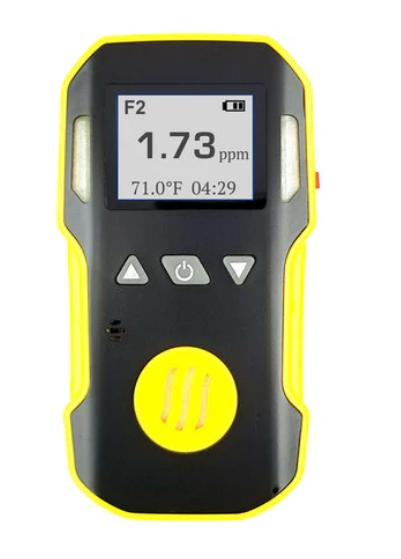Fluorine gas detection is crucial when working with fluorine, a highly toxic and corrosive gas used in various industries, including rocket fuel, fluorides, fluorocarbons, uranium, semiconductors, pharmaceuticals, and electronics. Despite its prevalence in modern life, such as in water and toothpaste, fluorine gas inhalation poses significant health risks. To protect humans from the dangers of high F2 gas exposure, reliable fluorine detectors are essential. A fluorine gas detector continuously monitors the presence and concentration of fluorine gas, alerting personnel to potential leaks or hazardous levels. By prioritizing gas detection, industries can safely harness the benefits of fluorine while minimizing the risk of harmful inhalation.
Pros |
Cons |
|
✅ Fluorine gas is a toxic and corrosive gas ✅ A Fluorine detector is used to detect Fluorine F2 gas in the air ✅ A Fluorine detector may be useful in applications such as industrial manufacturing and research and development, to reduce the risk of F2 gas inhalation and exposure |
⛔ Fluorine gas is not a common gas, and hence few folks know much about it ⛔ Fluorine gas detectors are expensive ⛔ Fluorine is a light gas and will have a tendency to elevate, making it hard to detect |
Best Fluorine Detector?
A Fluorine detector is used in the semiconductor, uranium energy, flat panel display industry and rocket fuel industry. Some reputable Fluorine Gas Detectors include:
- Forensics Detectors Fluorine Detector
- ATI Wall Mount F2 Gas Monitor
- RKI Eagle Fluorine Gas Detector
- Portasens Fluorine Handheld Gas Detector
What are the Exposure Limits of Fluorine Gas?
OSHA: The permissible exposure limit (8 hour) is 0.1ppm.
NIOSH: The recommended airborne exposure limit is 0.1 ppm averaged over a 10-hour workshift.
ACGIH: The recommended airborne exposure limit is 1 ppm averaged over an 8-hour workshift and 2 ppm as a STEL (short term exposure limit).
How do you Test for Fluorine Gas?
Fluorine is very light and reactive, so F2 gas detection is tricky. Although fluorine can be detected by scent (it has odor threshold for humans - detection limit of about 0.02), only a fluorine gas detector can correctly determine the gas's quantities in an indoor space. A fixed or portable ppm fluorine gas detection system can be used to provide continuous indoor air quality protection.
What is Fluorine Gas Used For?
Fluorine gas has many applications. Frequently, it is used in the production of other materials, and other compounds, but in some cases F2 gas is useful on its own:
- Semiconductor Industry uses it as a etchant, to etch silicon.
- Pharmaceutical industry uses it to make toothpaste and the water industry uses it also to protect teeth where compounds of fluorine, such as sodium fluoride, are used in toothpaste and in drinking water to prevent dental cavities.
- Energy Uranium industry uses it to make uranium hexafluoride in order to process nuclear fuel.
- Energy industry uses to make sulfur hexafluoride, the insulating gas for high-power electricity transformers.
- Chemical Industry uses it to make fluorochemicals, including solvents and high-temperature plastics, such as Teflon (poly(tetrafluoroethene), PTFE)
What is Fluorine Gas?
Fluorine is a gas of diatomic molecules (F2) that is light yellow when pure and exists at room temperature (sometimes described as yellow-green). It has a distinctive halogen-like strong and biting smell that can be detected at 0.01 to 0.002ppm. It is also the most reactive chemical, hence used as a rocket fuel. With the exception of oxygen, helium, neon, and krypton, it reacts with every other element, often quite violently. Fluorine is mostly found in the minerals fluorspar (CaF2) and cryolite in nature (Na3AlF6). Fluorine is made commercially by electrolyzing a solution of molten potassium fluoride and hydrofluoric acid. At the anode, fluorine gas is produced, and at the cathode, hydrogen gas.
Is Fluorine Gas Harmful?
Fluorine gas is indeed harmful.
Fluorine is a severe irritant to the eyes, mucous membranes, lungs, and skin; the eyes and the respiratory tract are the target organ and tissues of an acute inhalation exposure. Death is due to pulmonary edema.
How Do You Select a Fluorine Gas Detector?
When selecting a fluorine gas detector, the first question to be asked if a handheld unit or wall mount stationary unit is required?
For devices intended to move with employees, a portable fluorine gas detector is most appropriate. Such devices are often designed to be easily held by the user or even affixed to an article of clothing such as a belt.

Who Uses a Fluorine Gas Detector?
Most often, those working in an industrial production facilities may require a fluorine gas detector to ensure they are not exposed to high concentrations.
Furthermore, scientific researchers may also find a use for a fluorine gas detector if they are using fluorine gas to study chemical reactions or to produce other derivate compounds.

How is a Fluorine Gas Sensor Calibrated?
There are no F2 gas standards for compressed gas cylinders. This makes calibrating F2 a bit tricky.
Other oxidizing gases such as HCl, NO2, O3 and CL2 can be used to calibrate F2 gas detectors. A chlorine gas standard is typically used to calibrate a F2 gas sensor.
Is Fluorine Gas Corrosive?
Yes.
Fluorine is the most electronegative element. This means that in molecules fluorine attracts electrons more powerfully than any other element can.
Which Industries Readily Use Fluorine Gas Detectors?
Industries that employ fluorine gas in their manufacturing processes readily use fluorine gas detectors. While not exhaustive, the following list outlines some of the most common of such manufacturing industries:
- Chemical
- Nuclear Energy
- Water Treatment
- Semiconductor & Flat Panel Manufacturing
- Pharmaceutical

How Does a Fluorine Gas Detector Work?
Fluorine gas detectors all function using the same basic principle. A F2 gas detects the F2 gas molecules then passes this information (via electronic current magnitude) to the CPU. The computer calculates and maps this to a calibration curve. Then the computer displays the the output to the user in a ppm concentration scale.
Have Any Hazardous Accidents Occurred Because of Fluorine Gas?
Yes, a variety of accidents have occurred because of fluorine gas.
- Fluorine processing company had a major explosion with 3 dead.
- Clemson University had their fluorine gas lab shutdown.
- Tiger of Chemistry, accidents by fluorine gas.
- Berkeley University, lab accident with fluorine gas.
How is Fluorine Gas generated?
Fluorine gas is generated using a fluorine cell via a method called fluorine electrolysis often called Moissans method. Some of these electroysis cells are shown below.


Can You Smell Fluorine?
Yes, fluorine has a sharp, pungent, and irritating odor. However, smelling it is extremely dangerous as it's highly toxic and can cause severe respiratory damage.
Final Words
Gas detection is crucial when dealing with fluorine, as prolonged exposure to this gas or its liquid form can cause significant harm. Fluorine gas detectors play a vital role in reducing the risk of unnecessary exposure for employees working with F2 gas in various industrial applications, such as the uranium, semiconductor, and chemical industries. Although fluorine gas detectors can be expensive, they are essential for ensuring the safety of workers and preventing potential health hazards associated with fluorine exposure. By prioritizing gas detection and investing in reliable F2 detectors, companies can create a safer work environment and protect their employees from the dangers of this toxic gas.
About the Author
Dr. Kos Galatsis ("Dr.Koz") is the President of FORENSICS DETECTORS, where the company operates from the scenic Palos Verdes Peninsula in Los Angeles, California. He is a subject matter expert on gas sensor technology, gas detectors, gas meters, and gas analyzers. He has been designing, building, manufacturing, and testing toxic gas detection systems for over 20 years.

Every day is a blessing for Dr. Koz. He loves to help customers solve their unique problems. Dr. Koz also loves spending time with his wife and his three children going to the beach, grilling burgers, and enjoying the outdoors.
Read more about Forensics Detectors here.
Email: drkoz@forensicsdetectors.com
Phone: +1 424-341-3886

